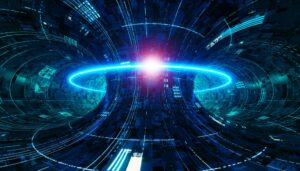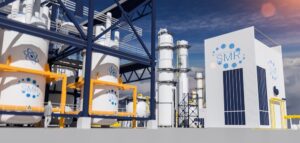
(MeshCube/Shutterstock)
The story of fusion has always been about generating clean and reliable energy. However, the key to making it real may be less about magnets and plasma than data — how it’s generated, simulated and interpreted. Every experiment generates massive volumes of it: terabytes of plasma readings, maps of magnetic fields and measurements of heat flux. It’s a deluge too powerful for old models to process. And translating that into understanding is beginning to feel more like an AI problem than a physics one.
That is what the new partnership between DeepMind and Commonwealth Fusion Systems (CFS) is about. CFS, the MIT spinoff that is developing the compact SPARC reactor, hopes to demonstrate that controlled fusion can, at long last, generate more energy than it consumes. DeepMind’s job is to work toward making that vision real — not by building the hardware, but by training machines to read, predict and control what’s going on inside a miniature fusion core.
The focal point of the collaboration is TORAX, a differentiable physics simulator developed by DeepMind, and a collection of reinforcement learning models that learn from synthetic plasma data. Together, they create a closed-loop system that trains using synthetic simulations it can generate at scale.: predicting how the plasma will behave, determining which adjustments keep it stable and feeding that knowledge back into CFS’s experiments. It is, simply put, an AI control architecture designed to maintain plasma stability — something no fusion reactor has ever sustained long enough for net energy gain.
It all comes down to control. To contain plasma is to attempt to control liquid lightning. Every single magnetic pulse or change in temperature sends shock waves through dozens of other variables, creating a network of feedback loops that combine with breathtaking complexity and speed — far too fast for any human to track in real time. The challenge for DeepMind is to make that chaos legible — to translate raw sensor data into structured signals that a machine can respond to faster than any engineer could.
TORAX simulates synthetic datasets that illustrate how the plasma could behave in millions of potential configurations. The reinforcement learning models then sift through that data, looking for the combinations that keep SPARC’s plasma balanced and productive.
As actual sensor data starts coming in, the system will compare what really happened with its predictions and begin to learn. The model and the machine evolve over many runs together — an adaptive data system that isn’t just a description of fusion, but learns to keep it alive.
“TORAX is a cutting-edge, open-source plasma simulator in the professional space and saved us many man-hours of creating and maintaining our simulation environments for SPARC,” says Devon Battaglia, senior manager, Physics Operations at CFS. “It’s now an essential aspect of our work to understand how the plasma will behave under different conditions.”
According to DeepMind, “The integration of our AI technologies with CFS’s cutting-edge experimental hardware is a natural and exciting collaboration that we hope will unlock new opportunities for science.”
But there’s also another level to this story. This is not just about getting fusion to work — it’s also about the rising overlap of AI and energy more broadly. As models grow and data centers guzzle more electricity, tech companies are dreading the days of incremental progress. They are thinking about long-term energy supply.
That’s how Google, the parent company behind DeepMind, invested in CFS’s $863 million Series B2 round and agreeing to purchase 200 megawatts of power under a future PPA from its first commercial fusion plant in Virginia. DeepMind’s fusion research doesn’t exist in a bubble; it feeds into Google’s broader initiative to power its infrastructure with carbon-free energy.
And technically, it makes sense. Fusion reactors are among the most complicated machines that humans have ever built. Thousands of variables — magnetic fields, fuel injection and exhaust, plasma density — can be controlled but interact constantly and unpredictably. Engineers have quipped that there are just “too many knobs for humans to turn.” That’s precisely the sort of problem reinforcement learning was designed to solve: a system that pokes and prods — and learns — by running millions of simulated scenarios until it finds the one that works.
“Using TORAX in combination with reinforcement learning or evolutionary search approaches like AlphaEvolve, our AI agents can explore vast numbers of potential operating scenarios in simulation, rapidly identifying the most efficient and robust paths to generating net energy,” shared Deepmind. “This can help CFS focus on the most promising strategies, increasing the probability of success from day one, even before SPARC is fully commissioned and operating at full power.”
When running at full power, SPARC will generate extraordinary heat in a tiny volume just off its inner wall. Keeping a lid on the exhaust from that model requires magnetic adjustments in milliseconds — which is what DeepMind’s AI agents are now being taught to do. Preliminary simulations show that they can learn to spread heat loads across the reactor’s inner wall or divertor, helping materials stay within safe thermal limits.
Whereas previous simulators were written in older languages, TORAX is coded in JAX and runs atop GPUs — the same hardware that powers modern AI models. This means that it can conduct millions of quick, differentiable simulations in parallel, merging high-energy physics with the computing infrastructure that already underlies today’s machine learning research.
DeepMind’s team says this is just the start.“We’re laying the foundations for AI to be an intelligent, adaptive system at the center of a future fusion power plant,” they wrote. If that vision plays out, fusion reactors may no longer rely on physicists turning knobs — they could operate more like self-optimizing software, constantly recalibrating based on new data, learning with every pulse, and moving fusion science closer to becoming energy reality.
Related Items
OpenAI Aims to Dominate the AI Grid With Five New Data Centers
MetaGraph Aims To Be The “Google For DNA,” Giving Scientists Control Of Big Data
Ai2’s DataVoyager Lets Scientists Talk to Their Data



